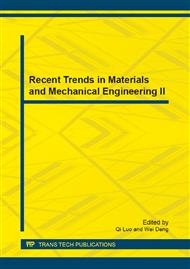p.209
p.215
p.222
p.230
p.234
p.240
p.246
p.250
p.254
Research on the Friction and Wear Properties of the NBR under Dry Sliding and Water Lubrication
Abstract:
The wear mechanisms of different graphite contents of NBR by 45# steel under dry sliding and water lubrication were investigated. On MPV-600 computer-controlled abrasive wear testing machine, the coefficients of friction were measured continuously. Results showed that under dry sliding condition, the rubber wear loss is big, the coefficient of friction is higher, the temperature of the friction surface is rise obviously. Wear loss and friction coefficient of NBR decrease with the increase of graphite contents; With the increase of graphite contents wear loss and the friction coefficient decreases, and is mainly due to the graphite lubrication performance and increase the stiffness of the rubber contact area. At low content of graphite, adhesive wear of NBR is showed, in the high content of graphite, abrasive wear is showed. Water lubrication condition, wear surface level off, the wear loss is very small, and the lubrication and cooling effect of water makes the friction coefficient decrease. Graphite content is higher, the wear loss and coefficient of friction is smaller.
Info:
Periodical:
Pages:
234-239
Citation:
Online since:
September 2013
Authors:
Keywords:
Price:
Сopyright:
© 2013 Trans Tech Publications Ltd. All Rights Reserved
Share:
Citation:


